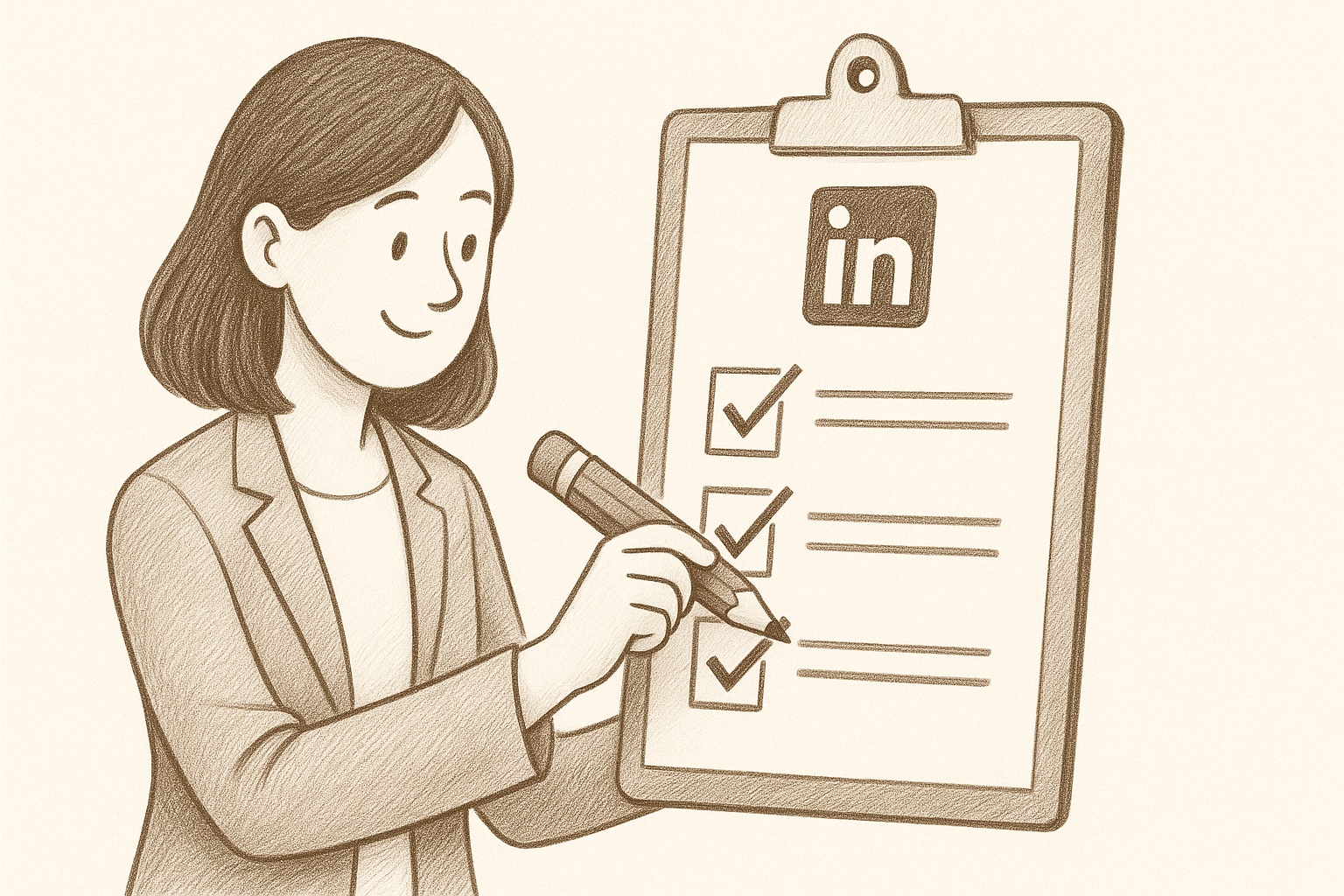The Founder's LinkedIn Personal Branding Checklist: From Invisible to Inevitable

I used to cringe every time someone said “personal branding.”
It felt like putting on a performance, creating some fake online persona that had nothing to do with who I actually was. But then I realized something that changed everything: Personal branding isn’t about creating a fake version of yourself—it’s about amplifying the authentic version that solves problems for other people.
Eighteen months ago, my LinkedIn presence was invisible. Despite being a founder with real traction, I was just another face in the crowd. Prospects didn’t recognize my name. Other founders didn’t know what I did. Investors couldn’t find me when they needed my expertise.
Today, that’s completely different. My personal brand on LinkedIn has become our biggest competitive advantage:
- Inbound demo requests increased by 340% after implementing systematic personal branding
- Speaking opportunities at major conferences started flowing in organically
- Strategic partnerships worth millions initiated because people recognized my expertise
- Media mentions and podcast invites became a weekly occurrence
- Our hiring became exponentially easier as top talent sought us out
The transformation didn’t happen overnight, but it followed a systematic approach. Here’s the exact 15-point checklist that took me from invisible founder to recognized industry voice—and how you can implement it starting today.
The Personal Branding Paradox for Founders
Here’s what most founders get wrong about personal branding: they think it’s about them.
It’s not.
Your personal brand is about the value you create for others. It’s about becoming the person your ideal customers, partners, and team members think of first when they have a problem you can solve.
The strongest founder personal brands have three core elements:
- Clear expertise positioning (what you’re uniquely good at)
- Consistent value delivery (how you help others consistently)
- Authentic storytelling (why people should trust and remember you)
Every item on this checklist serves one of these three pillars.
FOUNDATION LAYER: Building Your Brand Foundation (Items 1-5)
✅ Item 1: Define Your Unique Value Proposition
Before optimizing anything on LinkedIn, get crystal clear on what makes you different.
The exercise: Complete this sentence: “I help [specific audience] achieve [specific outcome] through [your unique approach].”
Examples:
- “I help B2B SaaS founders reduce customer churn through behavioral psychology frameworks”
- “I help e-commerce brands scale to 8-figures using data-driven creative testing”
- “I help service businesses automate operations without losing the personal touch”
Your UVP becomes the filter for every piece of content, every connection, and every conversation.
Implementation tip: Write this down and put it somewhere you’ll see it daily. Everything you post should somehow relate back to this core value proposition.
✅ Item 2: Identify Your Content Pillars
Most founders post randomly about whatever’s on their mind. Strategic founders build their brand around 3-4 consistent themes.
The Framework:
- Pillar 1: Your core expertise (the problem you solve)
- Pillar 2: Industry insights (trends and analysis)
- Pillar 3: Founder journey (lessons learned, behind-the-scenes)
- Pillar 4: Customer success (results and transformations)
My content pillars:
- LinkedIn automation and outreach strategy
- Founder-led sales and growth
- Building and scaling a remote team
- Customer success stories and case studies
Pro tip: Every piece of content should clearly fit into one of your pillars. If it doesn’t, don’t post it.
✅ Item 3: Audit Your Current LinkedIn Presence
Before building your brand, understand where you’re starting from.
The 10-Point Current State Assessment:
- Profile photo: Professional and approachable?
- Headline: Clear value proposition or generic title?
- About section: Customer-focused or company-focused?
- Experience: Results-oriented or responsibility-focused?
- Recent posts: Valuable insights or random thoughts?
- Engagement: Meaningful conversations or silence?
- Connections: Quality relationships or number-chasing?
- Content frequency: Consistent schedule or sporadic posting?
- Comment quality: Thoughtful responses or generic reactions?
- Overall message: Clear expertise or confusing positioning?
Be brutally honest. Most founders score 3-4 out of 10 when they start this process.
✅ Item 4: Research Your Ideal Audience
You can’t build a brand that resonates if you don’t understand who you’re trying to reach.
The Deep Dive Process:
Step 1: Identify 10-20 ideal customers, partners, or team members Step 2: Analyze their LinkedIn profiles for:
- What content they engage with
- Which influencers they follow
- What language they use to describe problems
- Which topics generate the most discussion
Step 3: Find the common threads and patterns Step 4: Create your “ideal audience avatar” for content planning
What you’re looking for:
- Pain points they discuss regularly
- Industry terms and jargon they use
- Content formats they prefer (video, text, images)
- Times and days they’re most active
✅ Item 5: Establish Your Brand Voice and Tone
Your brand voice is how you communicate consistently across all interactions.
The Voice Definition Framework:
If your brand were a person, how would they:
- Explain complex concepts? (Simple/technical, casual/formal)
- React to industry drama? (Diplomatic/direct, humorous/serious)
- Share personal stories? (Vulnerable/private, detailed/high-level)
- Disagree with someone? (Respectful/blunt, public/private)
My brand voice:
- Conversational but credible: I explain complex growth concepts in simple terms
- Data-driven but human: I share specific metrics but always include the human story
- Confident but humble: I share what’s working without claiming to have all the answers
- Helpful but honest: I provide value first but don’t sugarcoat difficult truths
Document your voice guidelines and refer to them before publishing any content.
VISIBILITY LAYER: Getting Found and Recognized (Items 6-10)
✅ Item 6: Optimize for LinkedIn Search
Personal branding without visibility is just journaling. You need to be found by the right people.
The Search Optimization Strategy:
Your headline should include:
- Primary keywords your audience searches for
- Your unique value proposition
- Social proof or credentials
Your About section should include:
- Industry-specific terms naturally throughout
- Problems you solve (using customer language)
- Results and outcomes you deliver
Skills section optimization:
- List skills your ideal customers would search for
- Get endorsed by credible people in your network
- Regularly update based on what’s working
Greenroom insight: We’ve helped founders increase search visibility by 300%+ just by optimizing these three areas with the right keywords.
✅ Item 7: Create a Content Calendar
Consistency beats perfection in personal branding. A mediocre post published consistently outperforms a perfect post published randomly.
The Weekly Content Framework:
Monday: Industry insight or trend analysis Wednesday: Founder story or lesson learned Friday: Customer success story or valuable tool/resource
Content planning process:
- Monthly: Plan themes aligned with business goals
- Weekly: Batch create content for the upcoming week
- Daily: Engage authentically with your network
Pro tip: Use your content pillars to guide topic selection. If you can’t clearly identify which pillar a post supports, don’t publish it.
✅ Item 8: Master the Art of LinkedIn Storytelling
Stories stick in memory longer than facts. Every founder has powerful stories—most just don’t know how to tell them effectively.
The Story Framework That Works:
- Hook: Start with a moment of tension or surprise
- Context: Briefly set up the situation
- Challenge: What obstacle did you face?
- Action: What specific steps did you take?
- Result: What happened (be specific)
- Lesson: What insight can others apply?
Example structure: “Two years ago, I made a mistake that almost killed our company… [Brief context about the situation] The problem was… So I decided to… The result was… The lesson: [Actionable insight for readers]”
✅ Item 9: Build Strategic Relationships
Personal branding isn’t a solo game. The strongest brands are built through relationships with other respected voices in your industry.
The Relationship Building Strategy:
Tier 1: Industry leaders and influencers (aspirational connections) Tier 2: Peer founders and executives (mutual benefit relationships) Tier 3: Your ideal customers and prospects (business development) Tier 4: Your community (customers, employees, partners)
Monthly relationship building goals:
- Connect with 5 Tier 1 leaders (focus on value-first interactions)
- Engage meaningfully with 10 Tier 2 peers (comments, shares, collaboration)
- Have conversations with 20 Tier 3 prospects (genuine interest in their challenges)
- Amplify and support 50 Tier 4 community members (likes, shares, recommendations)
✅ Item 10: Develop Your Thought Leadership Topics
Thought leadership isn’t about having all the answers—it’s about asking better questions and sharing unique perspectives.
The Thought Leadership Development Process:
Step 1: Identify 3-5 topics where you have unique insight
- What do you see differently than industry consensus?
- What approaches have you tested that others haven’t?
- What conventional wisdom do you disagree with?
Step 2: Develop your point of view on each topic
- What’s your contrarian take?
- What evidence supports your position?
- What results have you achieved with this approach?
Step 3: Create content that demonstrates your perspective
- Case studies showing your approach in action
- Data analysis that supports your viewpoint
- Practical frameworks others can apply
My thought leadership topics:
- Why most LinkedIn automation fails (and what works instead)
- The future of founder-led sales in remote-first companies
- Building sustainable growth without burning out your team
ENGAGEMENT LAYER: Building Community and Trust (Items 11-15)
✅ Item 11: Create Valuable Lead Magnets
The best personal brands don’t just attract attention—they capture it through valuable resources.
High-Impact Lead Magnet Ideas:
Templates and frameworks: Share the actual tools you use internally Industry reports: Compile insights from your customer base Video tutorials: Screen recordings showing your process Community access: Invite people into exclusive founder groups Office hours: Regular time when people can ask you questions
Distribution strategy:
- Feature prominently in your LinkedIn About section
- Reference in relevant posts with clear calls-to-action
- Share in comments when genuinely helpful
- Include in your email signature and speaking bios
Greenroom case study: Our “Founder’s LinkedIn Outreach Toolkit” has generated over 1,000 qualified leads while establishing our expertise in the space.
✅ Item 12: Engage Authentically with Your Network
Building a personal brand isn’t about broadcasting—it’s about having conversations.
The Authentic Engagement Framework:
Daily engagement goals:
- Leave 5 thoughtful comments on posts from your ideal audience
- Respond to every comment on your own posts within 4 hours
- Send 2 personalized messages to people who engaged with your content
- Share 1 piece of content from your network with your own insights added
Quality over quantity:
- One thoughtful, value-adding comment beats ten generic reactions
- Genuine questions that start conversations outperform statements
- Specific, personal responses show you actually read the post
✅ Item 13: Leverage Social Proof Strategically
Personal brands are built on credibility, and credibility comes from what others say about you.
The Social Proof Collection System:
Customer testimonials: Regularly ask satisfied customers to share their experience Media mentions: Keep a running list of press coverage and speaking engagements Partner endorsements: Request recommendations from strategic partners Team testimonials: Let your employees share what it’s like working with you Industry recognition: Apply for relevant awards and recognition programs
Strategic display:
- Update your About section with recent achievements
- Share media mentions as posts (with gratitude, not bragging)
- Include testimonials in your Featured section
- Reference social proof naturally in conversations
✅ Item 14: Monitor and Respond to Brand Mentions
Your personal brand extends beyond what you post—it includes what others say about you.
The Brand Monitoring System:
Set up Google Alerts for:
- Your name and company name
- Your key expertise topics
- Industry conversations you should join
LinkedIn monitoring:
- Search for mentions of your name weekly
- Track who’s sharing your content
- Notice when people reference your ideas without attribution
Response strategy:
- Thank people who mention you positively
- Engage in conversations about your expertise areas
- Gently correct misinformation when necessary
- Join discussions where you can add unique value
✅ Item 15: Measure and Optimize Your Brand Impact
Personal branding without measurement is just hope. Track the metrics that matter for your business goals.
Personal Brand KPIs:
Awareness metrics:
- Monthly profile views and search appearances
- Mentions of your name in industry conversations
- Speaking and media opportunities received
Engagement metrics:
- Comments and shares on your content
- Quality of people engaging with your posts
- Direct messages and connection requests received
Business impact metrics:
- Leads generated from personal brand activities
- Partnership opportunities created
- Team members attracted through your brand
- Sales cycles shortened due to brand recognition
Monthly brand review:
- What’s working? Which content and engagement drives best results?
- What’s not? Which activities aren’t moving the needle?
- What’s next? How will you evolve your brand next month?
The 90-Day Personal Brand Sprint
Ready to transform your LinkedIn personal brand? Here’s your implementation roadmap:
Days 1-30: Foundation Building
Week 1: Complete items 1-5 (foundation assessment and planning) Week 2: Optimize profile elements and begin content planning Week 3: Launch consistent posting schedule Week 4: Begin strategic relationship building
Days 31-60: Visibility Building
Week 5-6: Implement items 6-8 (search optimization and storytelling) Week 7-8: Execute items 9-10 (relationships and thought leadership)
Days 61-90: Engagement Building
Week 9-10: Launch items 11-13 (lead magnets and social proof) Week 11-12: Implement items 14-15 (monitoring and optimization)
Common Personal Branding Mistakes That Kill Credibility
The “Fake It Till You Make It” Trap
Mistake: Pretending to be further along than you actually are Fix: Be honest about your current stage while demonstrating your unique insights
The “Everything to Everyone” Problem
Mistake: Trying to appeal to every possible audience Fix: Get laser-focused on your ideal audience and speak directly to them
The “Perfection Paralysis” Issue
Mistake: Waiting until you have it all figured out before starting Fix: Start with your current knowledge and improve through consistent action
The “Promotion Only” Approach
Mistake: Only posting when you have something to sell Fix: Provide value consistently, with occasional promotional content
The “Inconsistency” Brand Killer
Mistake: Posting sporadically without a clear strategy Fix: Commit to a sustainable schedule and stick to it
Industry-Specific Brand Building Strategies
B2B SaaS Founders
Focus on: Customer success metrics, industry insights, product development lessons Content themes: Growth strategies, customer acquisition, scaling challenges Key relationships: Other SaaS founders, industry analysts, customer champions
E-commerce Founders
Focus on: Revenue growth, customer experience, market trends Content themes: Consumer behavior, marketing strategies, operational excellence Key relationships: Marketplace partners, marketing experts, successful brand builders
Service Business Founders
Focus on: Client transformations, industry expertise, methodology Content themes: Best practices, case studies, industry evolution Key relationships: Client champions, industry thought leaders, referral partners
How Greenroom Amplifies Your Personal Brand
While organic personal branding is essential, strategic automation can accelerate your results without compromising authenticity.
Where Greenroom helps:
- Relationship building: Systematically connect with your ideal audience while maintaining personal touch
- Engagement consistency: Never miss an opportunity to engage with important conversations
- Content amplification: Ensure your valuable content reaches the right people at the right time
- Lead capture: Systematically follow up with people who engage with your brand
The balance: Automation handles the systematic work so you can focus on creating genuine value and building real relationships.
Your Personal Brand ROI Calculator
Strong personal brands generate measurable business results. Here’s how to calculate your ROI:
Revenue Impact:
- Leads generated through brand recognition
- Deals closed faster due to pre-built trust
- Premium pricing justified by brand reputation
- Partnership revenue from brand-driven connections
Cost Savings:
- Reduced customer acquisition costs
- Lower recruiting expenses
- Decreased sales cycle length
- Less marketing spend needed for awareness
Strategic Value:
- Speaking opportunities and media coverage
- Industry recognition and awards
- Competitive differentiation
- Exit valuation premium
Example calculation: If your personal brand generates 10 additional qualified leads per month, and your close rate is 20% with an average deal size of $10,000, that’s $20,000 monthly revenue directly attributable to your brand efforts.
The Long-Term Personal Brand Vision
Personal branding isn’t a sprint—it’s a marathon that compounds over time.
Year 1: Build foundation and establish consistent presence Year 2: Develop thought leadership and industry recognition Year 3: Become the go-to expert in your specific niche Year 5: Achieve industry authority that opens doors automatically
The founders who think in decades rather than quarters build personal brands that become their greatest competitive advantage.
Your Next Steps
Personal branding can feel overwhelming, but you don’t need to implement everything at once. Start with these five items:
- Define your unique value proposition (Item 1)
- Audit your current presence (Item 3)
- Create your content calendar (Item 7)
- Begin strategic relationship building (Item 9)
- Set up measurement systems (Item 15)
Focus on these for 30 days, then gradually add the other elements as they become habits.
Remember: Your personal brand is already being built—either intentionally by you, or accidentally by others. The only question is: do you want to control that narrative?
Your expertise has the power to solve real problems for real people. Personal branding is simply the systematic process of making sure the right people know about it.
Start today. Your future customers, partners, and team members are waiting to discover what you have to offer.
Dom from Greenroom
Dom is the founder of Greenroom, a LinkedIn automation platform that helps entrepreneurs and sales professionals scale their outreach. He's helped thousands of professionals grow their LinkedIn presence and generate founder-led sales.

